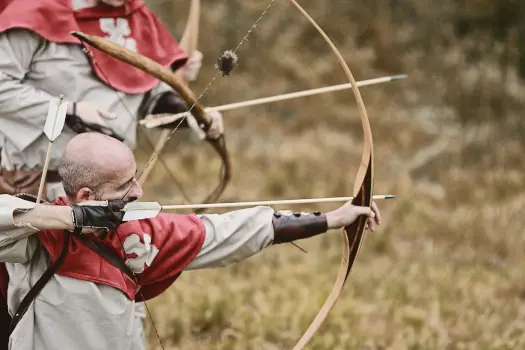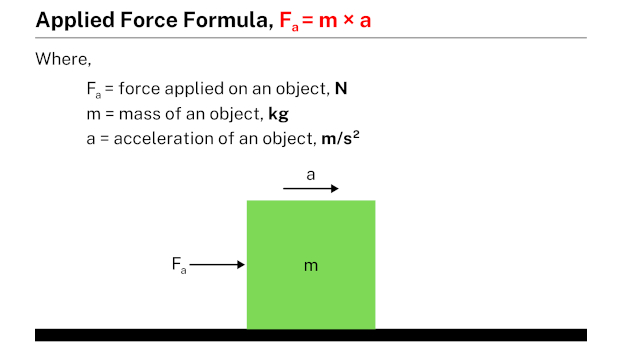An applied force refers to the force exerted on an object by another object or a person.[1][2] It is the result of a direct application of force to the object, typically through physical contact. The applied force can cause a change in the motion or state of the object, leading to acceleration or deformation, depending on the nature of the interaction.
Examples
Bicycle

When a child sits on a bicycle and someone pushes it from behind, it exemplifies applied force. Applied force is the action of one object exerting a force on another object, resulting in a change in its motion or state of rest. In this scenario, the force exerted by the person’s hand propels the bicycle forward, demonstrating the concept of applied force in action.
Soap dispenser

When pressing the lid of a hand soap dispenser with a finger, an applied force is exerted. In this example, the finger applies a downward force on the lid, causing it to be pushed into the dispenser. This applied force overcomes any resistance or friction present, allowing the lid to move and the soap to be dispensed.
Stress ball

When pressing a sponge ball with a hand, the hand applies a force to compress the sponge. This force causes the air pockets within the sponge to collapse, reducing its volume temporarily. As a result, the sponge becomes denser and changes shape. The applied force also determines the degree of compression and how much the sponge ball deforms under pressure.
Light switch

Turning a light switch on or off with a finger involves applying force to the switch mechanism. When the finger pushes or toggles the switch, it applies a force that changes the position of the switch contacts, either completing or breaking the electrical circuit. This action controls the flow of electricity to the light bulb, turning it on or off accordingly.
Pottery

When a potter molds a clay pot with their hand, they apply various forces to shape and manipulate the clay. These forces involve pressing, pinching, pulling, and smoothing the clay to achieve the desired form and texture. By applying pressure and manipulating the clay’s shape, the potter can create intricate designs and functional pottery pieces.
Book

Lifting a book from the floor with the hand requires applying an upward force to overcome gravity. When the hand grasps the book and lifts it, the muscles in the hand and arm contract, generating the necessary force to raise the book against the pull of gravity. The applied force must exceed the gravitational force acting on the book to lift it off the floor.
Bow and arrow

When an archer stretches a bow, they apply force to flex the bow’s limbs. This force, known as draw weight, stores potential energy in the bow. As the archer pulls back on the bowstring, the limbs bend, storing elastic energy. When the arrow is released, this stored energy is transferred to the arrow, propelling it forward with greater speed and force.
Plastic bottle

Crushing a plastic bottle involves applying force to collapse the bottle. By squeezing or pressing the bottle, the applied force causes the plastic material to deform and buckle under pressure. The plastic bottle’s structure is altered as it undergoes plastic deformation, resulting in a change in shape and volume.
Door

Opening or closing a door involves applying force to the door handle or knob. When the hand grasps the handle and pushes or pulls, it applies a force that causes the door to move. This action results in the door either swinging open to allow passage through the doorway or swinging closed to block entry or exit. The movement of the door changes its position relative to the door frame, altering the accessibility of the space on either side of the door.
Mason jar

Loosening or tightening the lid of a glass mason jar requires applying force to rotate the lid. When the hand grips the lid and twists it clockwise (tightening) or counterclockwise (loosening), the applied force causes the threads on the lid and jar to engage or disengage. This action creates or breaks the seal between the lid and the jar’s mouth, making it easier to open or close the jar.
Formula

The applied force formula, represented by FA, describes the connection between mass (m) and acceleration (a). It states that the applied force is equal to the product of the mass and acceleration of an object. By utilizing the formula FA = m × a, it becomes possible to accurately calculate the magnitude of the force being applied to the object.
Practice problems
Problem #1
A bowling ball with a mass of 2 kg is accelerating forward at a rate of 20 m/s2. Calculate the applied force on the bowling ball.
Solution
Given data:
- Mass of a bowling ball, m = 2 kg
- Acceleration of a bowling ball, a = 20 m/s2
- Force applied on a bowling ball, FA = ?
Applying the formula:
- FA = m × a
- FA = 2 × 20
- FA = 40 N
Therefore, the force applied on a bowling ball is 40 N.
Problem #2
Determine the force applied to a 5 kg trolley in order to make it accelerate forward at a rate of 10 m/s2.
Solution
Given data:
- Force applied on a trolley, FA = ?
- Mass of a trolley, m = 5 kg
- Acceleration of a trolley, a = 10 m/s2
Applying the formula:
- FA = m × a
- FA = 5 × 10
- FA = 50 N
Therefore, the force applied on a trolley is 50 N.
Problem #3
What is the value of the force applied to a toy car with a mass of 1 kg, which is accelerating at a rate of 12 m/s2?
Solution
Given data:
- Force applied on a toy car, FA = ?
- Mass of a toy car, m = 1 kg
- Acceleration of a toy car, a = 12 m/s2
Applying the formula:
- FA = m × a
- FA = 1 × 12
- FA = 12 N
Therefore, the force applied on a toy car is 12 N.
Problem #4
Calculate the force applied to a 4 kg wooden block that is accelerating further at a rate of 36 m/s2.
Solution
Given data:
- Force applied on a wooden block, FA = ?
- Mass of a wooden block, m = 4 kg
- Acceleration of a wooden block, a = 36 m/s2
Applying the formula:
- FA = m × a
- FA = 4 × 36
- FA = 144 N
Therefore, the force applied on a wooden block is 144 N.
More topics
- Force
- Normal force
- Balanced force
- Unbalanced force
- Applied force
References
- Applied Force – University of Tasmania
- Flexi answers – What is the definition of applied force? – CK-12 Foundation
External links
- Types of Forces – The Physics Classroom
- Applied Force | Definition, Types & Examples – Study.com
- Applied Force by Ron Kurtus – School for Champions
- Applied Force – University of Tasmania
- What is an Applied Force? – AllTheScience
- What are some examples of applied forces? – Quora
- Applied Force in Physics Problems – Dummies
- Applied Force Calculator – Calculator Academy
Deep
Learnool.com was founded by Deep Rana, who is a mechanical engineer by profession and a blogger by passion. He has a good conceptual knowledge on different educational topics and he provides the same on this website. He loves to learn something new everyday and believes that the best utilization of free time is developing a new skill.
